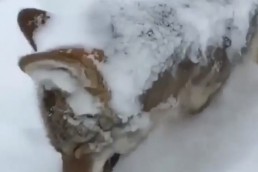Coyote Capers and House Cat Concerns
SHARE THIS POST
Pets that go missing have always been something of a mystery, but as urban sprawl and unchecked proliferation of coydogs collide, evidence of coyotes killing family pets is mounting. Last winter, residents of Mesa, Ariz. reported a rash of missing pets. At first, the residents weren’t sure what was ravaging their cuddly pals, until one of them saw a coyote loping down a street with a white cat in its mouth. She said she noticed it because a bell on the dead cat’s collar was “tinkling” as the coyote trotted along.
A lady who lives near the Alvamar Public Golf Course in Lawrence, Kans., regularly lets her cat wander the neighborhood at night. One night, the cat failed to return, but she did notice a coyote visiting her backyard. After spreading the news, she had learned that 10 of her neighbors had also lost pets, and had also seen the predators.
A Kentucky farmer once told me he kept a lot of free-ranging cats around to cut down on the rodent population in his grain bins. Once he started hearing coyotes howl at night, and over the winter, he went from having 18 to 20 cats to only one in a short period of time.
Coyotes are savvy and elusive, and you can often hear them yipping to celebrate a kill at night, but you seldom see them during the day. Their regular menu includes field rodents, rabbits and various birds, but they’ll eat anything they can manage. And with their numbers surpassing their natural food sources, they are becoming more aggressive and resourceful.
A lady in Kitchener, Ont. had a habit of letting her cat out for an hour every morning. One morning, she heard a commotion and opened her door to find her cat perched on a windowsill, with a coyote below it. The cat made a dash for the open door, but the coyote was faster, and scooped up the lady’s cat.
Authorities in San Francisco’s Golden Gate Park recently shot two coyotes after they attacked two leashed dogs being walked by their owner. And Seattle residents have reported sightings of coyotes sleeping in yards, wandering the streets and howling in reply to every siren they hear.
It’s not that coyotes are getting bolder; they’re just becoming more desperate.
Are you enjoying this post?
You can be among the first to get the latest info on where to go, what to use and how to use it!
All across the nation, coyotes are losing some of their fear of humans as the canine’s populations have swelled to unprecedented numbers. This is in part due to a politically correct “Walt Disney” idea of conservation. Animal rights activists have gradually fed society the notion that wild animals are just like good-hearted people who can’t talk—except of course in the movie or on TV—and seem to think these predators are cuddly critters who haven’t been petted enough. But these idealists are learning the hard way that real predators are not like a Disney cartoon character. These wild animals are invading backyards and snatching precious pets at will. They’re not evil; they’re simply living by eating smaller prey.
The reality is the coyote invasion into human-populated areas is way out of control. The idea of pragmatic predator control went out the window during the 1970s when “animal lovers” started throwing buckets of red paint on people who wore coats made of animal fur. When real fur became somewhat unfashionable—not in all circles and fashion seasons—most of the incentive to harvest and control coyotes consistently and effectively went with it.
In an ironic twist, the only thing that can stem the overpopulation of coyotes today is a renewed demand for fur—this predator’s fur. If more people wore coyote coats, our pitifully small upland game populations could make a needed rebound too.
As it stands, faux fur is considered more fashionable and sold more, and at the same time coyotes are becoming so numerous their range is expanding to the point that Wile E. Coyote is much better at catching Felix the Cat than he has been at catching the Roadrunner.
When pets are missing, we might hope for the best and think that some other animal lover snatched and adopted our missing pet along a roadway. But it’s becoming increasingly clear that our wandering loved ones may be encountering this large-toothed marauder.
With missing capers of lost pets becoming more prevalent, even the staunchest animal rights proponents may end up changing their minds about trapping and coyote hunting to save other animals that deserve it.
Did you enjoy this post?
You can be among the first to get the latest info on where to go, what to use and how to use it!
Ron Kruger
Ron Kruger has been communicating the outdoor experience for more than four decades. He has worked as a full-time guide for trout on the North Fork, for crappies and bass on Kentucky Lake and for smallmouths on the Current River. He has served as editor of three outdoor magazines, and owns a patent on a fly/lure called the Desperate Diver.

